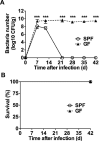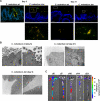Regulated virulence controls the ability of a pathogen to compete with the gut microbiota
- PMID: 22582016
- PMCID: PMC3439148
- DOI: 10.1126/science.1222195
Regulated virulence controls the ability of a pathogen to compete with the gut microbiota
Abstract
The virulence mechanisms that allow pathogens to colonize the intestine remain unclear. Here, we show that germ-free animals are unable to eradicate Citrobacter rodentium, a model for human infections with attaching and effacing bacteria. Early in infection, virulence genes were expressed and required for pathogen growth in conventionally raised mice but not germ-free mice. Virulence gene expression was down-regulated during the late phase of infection, which led to relocation of the pathogen to the intestinal lumen where it was outcompeted by commensals. The ability of commensals to outcompete C. rodentium was determined, at least in part, by the capacity of the pathogen and commensals to grow on structurally similar carbohydrates. Thus, pathogen colonization is controlled by bacterial virulence and through competition with metabolically related commensals.
Figures




Comment in
-
Microbiology. Virulence or competition?Science. 2012 Jun 8;336(6086):1238-9. doi: 10.1126/science.1223303. Epub 2012 May 10. Science. 2012. PMID: 22582015 No abstract available.
-
Microbiome: Pathogens and commensals fight it out.Nat Rev Microbiol. 2012 Jun 6;10(7):445. doi: 10.1038/nrmicro2818. Nat Rev Microbiol. 2012. PMID: 22669217 No abstract available.
References
Publication types
MeSH terms
Substances
Grants and funding
LinkOut - more resources
Full Text Sources
Other Literature Sources

